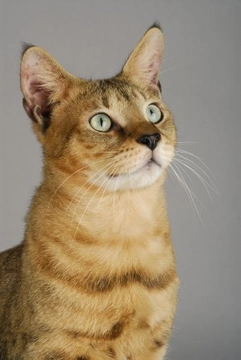
More Information on the Chausie Cat Breed
The Chausie cat is a large and fairly unusual breed, which is not yet hugely common in the UK. They were originally produced via the cross-breeding of a pool of non-domestic cats, Felis chaus, with a much larger pool of established domestic breeds of various types. Today, fourth-generation and later crosses are the most common Chausie cats, which have domestic temperaments while still retaining their wild looks. Due to their wild ancestry and relative rarity, the Chausie is one of the more expensive pedigree cat breeds to buy.
Chausie history
The first unintentionally produced Chausie cats are thought to have hailed from Egypt, possibly going back several thousand years ago. Felix chaus, the jungle cat, and Felix catus, the domestic cat, will sometimes interbreed independently in areas where there are significant numbers of both.
In their more recent history, Chausie breeding began in the 1960’s and 1970’s, in an attempt to find a workable option for keeping a non-domestic cat as a household pet. However, the organised breeding of the Chausie in earnest didn’t really get going until the 1990’s, when the breed was formally named. TICA, The International Cat Association, first registered and recognised the breed in 1995, and in 2013, the Chausie became the organisation’s newest championship breed.
Organised breeding of the Chausie now takes place in America and Europe, and the breed is currently going through the process of becoming recognised by the World Cat Federation.
Chausie appearance
The Chausie is a large breed, with the males often being significantly larger than the females. They have lean, lithe bodies that are muscular but not heavy. The hind legs should be slightly longer than the forelegs, with small, rounded paws. They are deep-chested with a wedge-shaped head, high cheekbones and long, close-set ears. The tail can range from three quarter length to full length.
The Chausie’s eyes are oval, and may range in colour between yellow, green and gold. The coat of the Chausie is short, with a coarse top coat and finer undercoat, and can be seen in three colours: black, grizzled tabby, or brown ticked tabby.
Chausie temperament
The wild cat Felis chaus, which provides the wild side of the Chausie species ancestry, is renowned for being outgoing, fun-loving and adventurous. The first generation crosses of Felis chaus with domestic cats drew from the gene pools of other very outgoing and intelligent breeds, such as the Oriental Shorthair and the Abyssinian, producing a breed that is highly active, very inquisitive, and very athletic too.
They are very personable and love company, either from other cats or people. If you do not have a lot of time to dedicate to spending with your cat, a Chausie would not be a good choice, and you should consider getting them a feline companion too. They also generally get on well with dogs. The Chausie forms a strong bond with their owners, and may have trouble settling into a new home as an adult. They are very loyal, affectionate and friendly with their favourite people!
Chausie health
The Chausie’s average lifespan is 12-14 years, which is the average for pedigree domestic cats of similar types.
Like many hybrid and wild cat breeds, the Chausie’s intestinal tract is sometimes shorter than the average domestic cat, which means it is less capable of processing fibre and plant matter, which usually compose a large part of pre-packed cat food diets. Feeding these products as standard may potentially lead to conditions including irritable bowel syndrome, intestinal inflammation and food allergies. The Chausie breed as a whole is rather more prone to developing food allergies than most other species.
In order to combat this problem, it is advisable to feed only a very high-quality diet, and preferably one that is grain free. It is possible to prepare meals for your Chausie from scratch too, such as feeding a raw and cooked meat diet supplemented with the essential nutrients that protein-based foods cannot provide.
Chausie care
The Chausie generations that are commonly offered for sale today largely possess the personality traits of the average domestic cat, rather than their wild ancestors. That said, they are likely to retain strong hunting instincts, and are more than likely to catch and bring home their prey on a regular basis, leaving you to clean it up! The Chausie shares a lot of the temperament traits and care requirements of many of the Oriental cat breeds, such as the Oriental Shorthair and the Siamese.
This means that they are lively, loving and rather demanding in terms of the amount of attention that they require, and will not thrive if they are lonely. If you have plenty of time to spend with your Chausie, they will bond with you strongly, as well as with other members of the family and other household pets.
The coat of the Chausie is short, and does not require a great deal of grooming or other care that the cat is unable to provide for themselves. Fulfilling the dietary requirements of the Chausie, as mentioned above, is generally considered as one of the main challenges of owning and managing this species.



